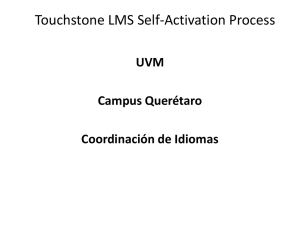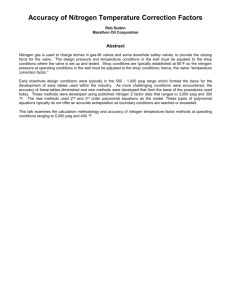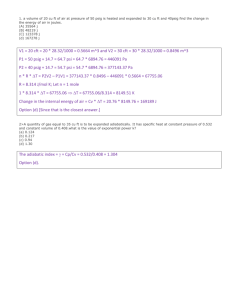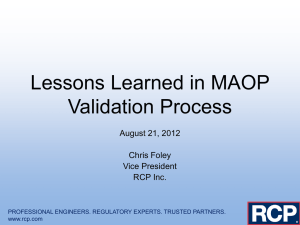P-192.739-Inspect-Calibrate-Maintain
advertisement
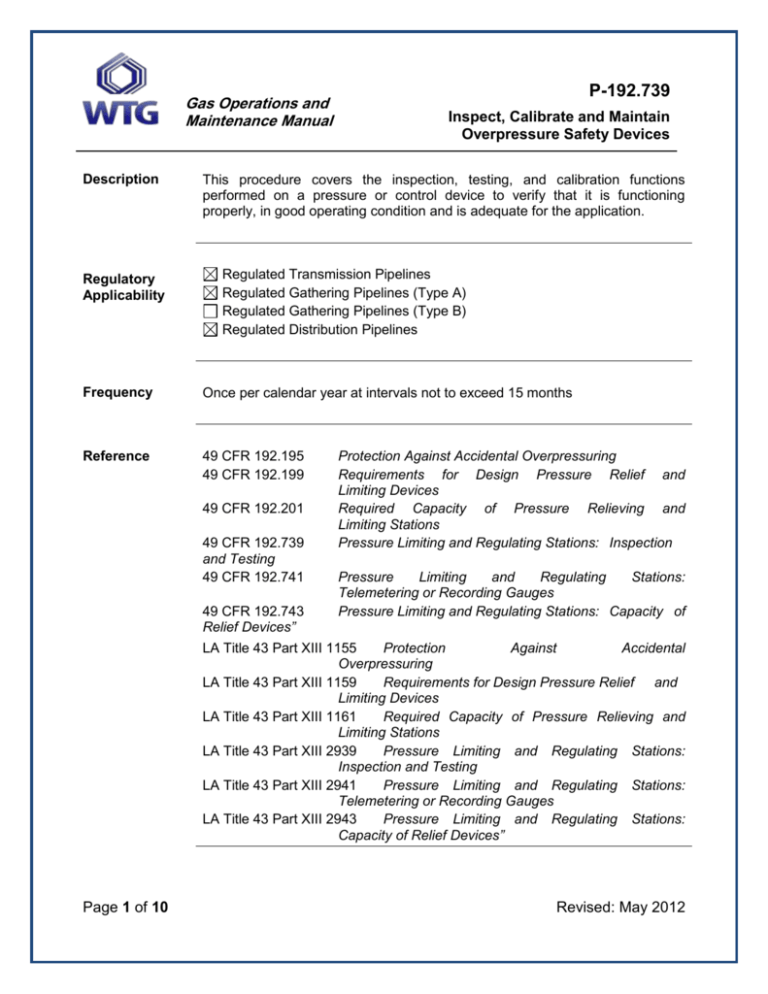
Gas Operations and Maintenance Manual Description Regulatory Applicability P-192.739 Inspect, Calibrate and Maintain Overpressure Safety Devices This procedure covers the inspection, testing, and calibration functions performed on a pressure or control device to verify that it is functioning properly, in good operating condition and is adequate for the application. Regulated Transmission Pipelines Regulated Gathering Pipelines (Type A) Regulated Gathering Pipelines (Type B) Regulated Distribution Pipelines Frequency Once per calendar year at intervals not to exceed 15 months Reference 49 CFR 192.195 49 CFR 192.199 49 CFR 192.201 49 CFR 192.739 and Testing 49 CFR 192.741 49 CFR 192.743 Relief Devices” Protection Against Accidental Overpressuring Requirements for Design Pressure Relief and Limiting Devices Required Capacity of Pressure Relieving and Limiting Stations Pressure Limiting and Regulating Stations: Inspection Pressure Limiting and Regulating Stations: Telemetering or Recording Gauges Pressure Limiting and Regulating Stations: Capacity of LA Title 43 Part XIII 1155 Protection Against Accidental Overpressuring LA Title 43 Part XIII 1159 Requirements for Design Pressure Relief and Limiting Devices LA Title 43 Part XIII 1161 Required Capacity of Pressure Relieving and Limiting Stations LA Title 43 Part XIII 2939 Pressure Limiting and Regulating Stations: Inspection and Testing LA Title 43 Part XIII 2941 Pressure Limiting and Regulating Stations: Telemetering or Recording Gauges LA Title 43 Part XIII 2943 Pressure Limiting and Regulating Stations: Capacity of Relief Devices” Page 1 of 10 Revised: May 2012 Gas Operations and Maintenance Manual Forms / Record Retention F-192.743 WTG 1102 Related Specifications None OQ Covered Task 0381 0391 0401 0221 P-192.739 Inspect, Calibrate and Maintain Overpressure Safety Devices Relief Device Capacity Determination Report / 2 Years Regulator Station Inspection Sheet / 2 Years Spring Loaded Pressure Regulated Device Inspection and Testing, Prevention Corrective Maintenance Pilot Operated Pressure Regulated Device Inspection and Testing, Prevention Corrective Maintenance Controller Type Pressure Regulated Device Inspection and Testing, Prevention Corrective Maintenance Inspect, test, and Maintain Sensing Devices – and – and – and (In order to perform the tasks listed above; personnel must be qualified in accordance with West Texas Gas’s Operator Qualification program or directly supervised by a qualified individual.) Page 2 of 10 Revised: May 2012 Gas Operations and Maintenance Manual P-192.739 Inspect, Calibrate and Maintain Overpressure Safety Devices Procedure Steps Overpressure devices, and equipment (including regulators, switches and transmitters) shall be inspected and tests made once per calendar year at intervals not to exceed fifteen (15) months to determine: a. In good mechanical condition. b. Adequate from the standpoint of capacity and reliability of operation for the service in which it is employed. c. Set to function at the correct pressure. d. Properly installed and protected from dirt, liquids, or other conditions that might prevent proper operation. e. If the equipment vents, vents must be terminate in an area that will not create a hazard to persons or other equipment and venting of gas shall not be obstructed. These devices must be set to limit the pressure in the pipeline below the MAOP (refer to procedure P-192.619). However if the MAOP is not determined according to P-192.619 these devices must operate at the following pressures: 1. In a low pressure distribution system, the pressure may not cause the unsafe operation of any connected and properly adjusted gas utilization equipment. 2. In pipelines other than a low pressure distribution system: a. If the MAOP is 12 psig or more but less than 60 psig, the pressure may not exceed the MAOP plus 6 psig; or b. If the MAOP is less than 12 psig the pressure may not exceed the MAOP plus 50%. However, if the MAOP is determined according to 49 CFR 192.619(c) and is 60 psi gauge or more, the control or relief pressure limit is as follows: 1. If the MAOP produces a hoop stress greater than 72% of SMYS, then the pressure limit is MAOP plus 4%. 2. If the MAOP produces a hoop stress of unknown percentage of SMYS, then the pressure limit is a pressure that will prevent unsafe operation of the pipeline considering its operating and maintenance history and MAOP. Pressure Switches and Transmitters Note: Refer to manufacturer’ procedures for specific equipment requirements and procedures for inspecting and maintaining. 1. Ensure the switch or transmitter is installed properly and protected from dirt, liquids and other conditions that may prevent proper operation. 2. Conditions that require replacement of transmitter or switch include Page 3 of 10 Revised: May 2012 Gas Operations and Maintenance Manual P-192.739 Inspect, Calibrate and Maintain Overpressure Safety Devices a) Switch cannot be calibrated b) Operating point is not repeatable c) Setpoint drifts d) Diaphragm has burst or says “fail” e) Transmitter/switch not stable 3. Pressure transmitters are compared on a daily basis to the local pressure gauge on the meter run. 4. When readings become more than 10 psig apart, a work order will be written to check transmitter out. 5. Transmitter will be isolated from the system and checked using a dead weight tester (certified to ± ½ %). 6. Obtain verification of device set point for switches and range of transmitter prior to performing calibration. 7. Adjust and calibrate pressure transmitter or switch according to device manufacturer’s specifications. 8. Determine correct test medium and range to be used for testing. 9. Isolate the pressure switch or transmitter from the process system. 10. Inspect all connections for leakage. 11. Apply test medium pressure and verify device set point or range “as found.” Verify pressure transmitters at zero, mid and full scale calibration points. 12. Trip switch and ensure alarm is activated in the control room. 13. If a transmitter or switch is inoperable: a) Notify supervisor b) Repair if possible c) Replace 14. Re-apply test medium for desired set point or range and adjust if necessary according to device manufacturer’s specifications to establish desired set point. 15. Document final set point setting(s), “as left.” 16. Verify that this pressure is consistent with 49 CFR Part 192.201(a) (See Verify Relief Device Capacity section of this procedure.). After calibration, a tag should be left on the device identifying the following information: a) Setting b) Name of person performing calibration c) Unit number Page 4 of 10 Revised: May 2012 Gas Operations and Maintenance Manual P-192.739 Inspect, Calibrate and Maintain Overpressure Safety Devices d) Date of calibration 17. NOTES: a) If there is an electrical short, locate the short and attempt to clear it i) Use an approved monitor for testing atmosphere before testing electronic devices because a hazardous atmosphere could cause an explosion if arcing occurs during equipment testing. b) In the event of an electric shock i) Disconnect electrical supply if necessary ii) Call 911 if necessary c) In cases where the transmitter is removed in order to test, it should, if possible be tested in the same position as it is in the field. d) The technicians perform a static alignment on the transmitter. A static calibration check and a dynamic calibration check are performed. e) Accuracy is acceptable if +.025 %. f) Transmitter to be repaired or replaced as required. Relief Valves Note: Refer to manufacturer’ procedures for specific equipment requirements and procedures for inspecting and maintaining. 1. Ensure the relief valve is installed properly and protected from dirt, liquids and other conditions that may prevent proper operation. 2. Verify location and valve number to be inspected. 3. Verify the accessibility of the valve. 4. Verify the valve number and nameplate data. 5. Verify the valve type and manufacturer. 6. Verify all set pressures with a certified pressure gauge or deadweight tester. 7. Isolate the relief valve from the pipeline system. 8. Apply test pressure from a secondary source into the space between the relief device block valve and the inlet of the relief device. 9. Record the pressure at the time of operation of the device. 10. If the device has not relieved at the proper set point, make necessary repairs with a new or rebuilt device. 11. Retest the device after repair or replacement to verify function and set point. Page 5 of 10 Revised: May 2012 Gas Operations and Maintenance Manual P-192.739 Inspect, Calibrate and Maintain Overpressure Safety Devices 12. After testing, re-pressure the inlet to the device to make sure the device is not leaking. 13. Visually inspect valve for wear and corrosion. 14. Apply security seal to valve as required by procedures. 15. Place the valve back in service. 16. Document results. 17. Verify that this pressure is consistent with 49 CFR Part 192.201(a). (See Verify Relief Device Capacity section of this procedure.) Pressure Limiting Devices Note: Refer to manufacturer’ procedures for specific equipment requirements and procedures for inspecting and maintaining. NOTE: Most control type valves operate with a diaphragm or bellows type actuator. A diaphragm type actuator functions because pressure or vacuum is applied to the diaphragm which causes valve position to change. 1. Ensure pressure limiting device is installed properly and protected from dirt, liquids and other conditions that may prevent proper operation. 2. Verify the proper rupture disc rating. Rupture disk ratings should not exceed the MAOP. 3. Obtain verification of device calibration set point prior to performing calibration. NOTE: Test gauges should be calibrated every year. 4. Determine correct test medium and range to be used for testing. 5. Isolate over pressure device from the process system. 6. Inspect all pilots, regulators, rupture discs, sensing devices and control valves for leakage. a) A continual loss of air or hydraulic pressure normally indicates valve or actuator failure. Valve actuators are normally repaired in the shop. b) Manufacturer’s repair procedures for one make and model of valve should not be used for other makes and models of valve even if the valves are similar in type. c) The rupture disc lifespan is determined by the manufacturer’s specifications. d) Rupture disc failure can be detected by obtaining a pressure reading on opposing side of disc or lower pressure on the downstream side of the device. 7. Apply test medium pressure and verify device “as found “set point”. 8. Document results. 9. Re-apply test medium for desired set point and make adjustments to device in accordance with device manufacturer’s specifications to establish desired set point. Page 6 of 10 Revised: May 2012 Gas Operations and Maintenance Manual P-192.739 Inspect, Calibrate and Maintain Overpressure Safety Devices WARNING: Do not apply excessive pressure to rupture disc assemblies. 10. Document final set point setting, “as left”. 11. Verify that this pressure is consistent with 49 CFR Part 192.201(a). (See Verify Relief Device Capacity section of this procedure.) Pressure Limiting and Regulating Monitors Note: Refer to manufacturer’ procedures for specific equipment requirements and procedures for inspecting and maintaining. 1. Install an appropriate test gauge on the downstream side of the regulator to monitor the pressure build-up. 2. Properly isolate and bypass the devices to be operated. 3. Slowly introduce pressure to the device and at the same time, monitor the pressure gauge to see if the regulator is set at the correct pressure and maintains the correct pressure. 4. The regulator should control the pressure within the buildup limits listed below: System MAOP Maximum Protected Pressure Up to 18” WC 27” WC 18” WC to 12 psig MAOP + 50% 12 psig to 60 psig MAOP + 6 psig Over 60 psig MAOP + 10% 5. If the device does not control pressure within the prescribed limits, immediate adjustments, repairs or replacement must be made. Pressure Limiting and Monitor Regulators Note: Refer to manufacturer’ procedures for specific equipment requirements and procedures for inspecting and maintaining. 1. Install an appropriate test gauge on the downstream side of the regulator to monitor the pressure buildup. 2. Properly bypass and isolate the device to be operated. 3. Slowly introduce pressure to the device and at the same time, monitor the pressure gauge to see if the regulator is set at the correct pressure and maintains the correct pressure. 4. The regulator should control the pressure within the buildup limits: Page 7 of 10 Revised: May 2012 P-192.739 Gas Operations and Maintenance Manual System MAOP Inspect, Calibrate and Maintain Overpressure Safety Devices Maximum Protected Pressure Up to 18” WC 27” WC 18” WC to 12 psig MAOP + 50% 12 psig to 60 psig MAOP + 6 psig Over 60 psig MAOP + 10% 5. If the device does not control the pressure within the prescribed limits, immediate, adjustments, repairs or replacement must be made. 6. The results of each inspection shall be recorded on form WTG 1102. Verify or Set Protection Parameters Note: Refer to manufacturer’ procedures for specific equipment requirements and procedures for inspecting and maintaining. 1. Obtain verification of device set point or operating parameters to be implemented or changed. 2. Ensure proper isolation of the affected PLC program section from the Process System. 3. Verify data within the current program and document the data “as found”. Implement changes or install new programming section according to PLC manufacturer’s specifications. 1. Verify program acceptance through software or dynamic testing methods. 2. Document system alterations “as left”. 3. Verify that this pressure is consistent with 49 CFR Part 192.201(a). Verify Capacity of Regulator and Relief Devices 1. Each pressure relief or limiting station or group of these stations installed to protect the pipeline from overpressure must have enough capacity to insure the following: a) In a low-pressure distribution system, the pressure must not cause unsafe operation of any connected gas utilization equipment. b) Pressure relief or limiting devices connected to a low-pressure distribution system must be located at or near the source of gas and with a capacity to limit the maximum pressure on the system to a safe operating pressure for any connected utilization equipment. c) If the MAOP is 60 psi gauge or more, the pressure may not exceed the MAOP plus 10%, or, the pressure that produces a hoop stress of 75% of SMYS, whichever is lowest. d) If the MAOP is 12 psi gauge or more, but less than 60 psi gauge, the pressure may not exceed the MAOP plus 6 psi gauge. e) If the MAOP is less than 12 psi gauge, the pressure may not exceed the MAOP plus 50%. Page 8 of 10 Revised: May 2012 Gas Operations and Maintenance Manual P-192.739 Inspect, Calibrate and Maintain Overpressure Safety Devices 2. Either by testing the devices in place or by having engineering review and calculate the capacity of the relief devices, it must be annually ensured and documented (Form F-192.743) by the devices have sufficient capacity to protect the pipelines to which they are connected. 3. If review and calculations are used to determined sufficient capacity, the calculated capacity must be compared with the rated or experimentally determined relieving capacity of the device for the conditions under which it operates. After the initial calculations, subsequent calculations are not required if the annual review documents that parameters have not changed to cause the rated or experimentally determined relieving capacity to be insufficient. 4. If it is determined that the relief device capacity is insufficient, a new or additional device must be installed to provide the required capacity. Telemetering or Recording Gauges Note: Refer to manufacturer’ procedures for specific equipment requirements and procedures for inspecting and maintaining. 1. If the district is supplied by more than one regulating station, ensure telemetering or recording gauges are in place. 2. The District Manager will determine the need for these devices in distribution systems that are supplied by only one district station. This determination will take into consideration the number of customers supplied, the operating pressures, the capacity of the installation and other operating conditions. 3. If there are indications of abnormally high or low pressure, the regulator and the auxiliary equipment will be inspected and the necessary measures employed to correct any unsatisfactory operating conditions. Page 9 of 10 Revised: May 2012 Gas Operations and Maintenance Manual P-192.739 Inspect, Calibrate and Maintain Overpressure Safety Devices THIS PAGE INTENTIONALLY LEFT BLANK. Page 10 of 10 Revised: May 2012
